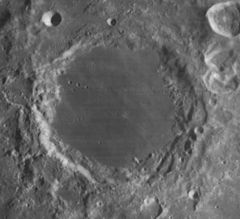
Boethius is a small lunar impact crater located on the east edge of Mare Undarum near the eastern lunar limb. To the southwest is the dark, lava-flooded crater Dubyago.

Apollonius is a lunar impact crater located near the eastern limb of the Moon. It lies in the region of uplands to the west of Mare Undarum and northeast of the Sinus Successus on the Mare Fecunditatis. It was named after Greek mathematician Apollonius of Perga. It is southwest of the crater Firmicus, and north of Condon.

Hercules is a prominent crater located in the northeast part of the Moon, to the west of the crater Atlas. It lies along the east edge of a southward extension in the Mare Frigoris. To the west across the mare is Bürg. To the south is the ruined crater Williams.

Abel is an ancient lunar impact crater that lies near the southeast limb of the Moon's near side. It is located to the south of the crater Barnard, at the northwest edge of the Mare Australe.
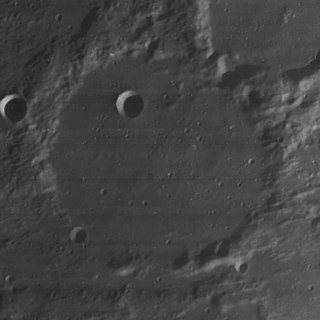
Arnold is a lunar impact crater that is located in the north-northeastern part of the visible Moon, near the lunar limb. This location gives the crater a notably oval appearance due to foreshortening, although the formation is actually relatively round. It lies to the northeast of the Mare Frigoris, to the north of the crater Democritus. West of Arnold is the smaller crater Moigno.

Birmingham is the surviving remnant of a lunar impact crater. It is named after the astronomer John Birmingham. The crater is located near the northern limb of the Moon, and so is viewed from the Earth at a low angle.
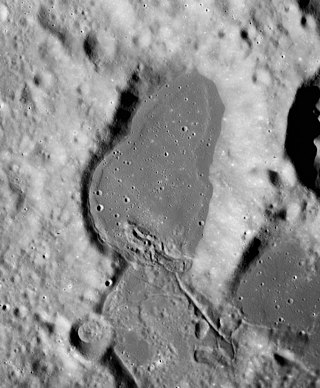
Bowditch is a lunar impact crater that lies on the far side of the Moon, just beyond the eastern limb. It is located on a region of the lunar surface that is brought into view due to libration, but at such times the area is viewed from the edge and so not much detail can be observed. It lies just to the north of the small Lacus Solitudinis lunar mare, between the craters Titius to the southwest and Perel'man to the east-northeast.
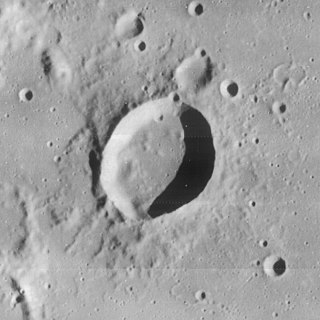
Clausius is a lunar impact crater that is located in the southwest part of the Moon, in the small lunar mare designated Lacus Excellentiae. It is completely enclosed by mare material, although the tiny satellite crater Clausius A lies just to the north. The rim of Clausius is low and sharp, with a slightly oval shape that is longer in the north–south direction. The interior floor has been flooded by basaltic lava, and appears level and featureless with a darker surface that matches the mare surface that surrounds the crater exterior.

Stewart is a small lunar impact crater that lies to the northeast of the Mare Spumans, a small lunar mare near the eastern limb of the Moon. It was named after American astrophysicist John Quincy Stewart. It is located to the north of the crater Pomortsev, and to the southwest of the lava-flooded Dubyago. Stewart was previously designated Dubyago Q before being named by the IAU. This is a circular crater with a low outer rim and a level, featureless interior floor.

Cusanus is a lunar impact crater that is located near the northeastern limb of the Moon. In this location the crater appears very foreshortened when observed from the Earth, and its visibility is affected by libration. The northern rim of Cusanus is nearly joined to the south-southeastern rim of the larger crater Petermann. To the west is Baillaud and to the southeast is Hayn.
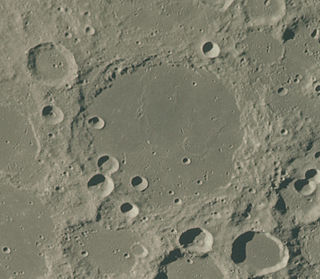
Lyot is a large lunar impact crater that is located along the southeastern limb of the Moon. It lies within the irregular and patchy lunar mare named Mare Australe, and to the south of the crater Hamilton. Due to its location, this formation is viewed at a low angle from the Earth, and its visibility is affected by libration.

Kopff is a lunar impact crater that lies along the eastern edge of the inner Mare Orientale impact basin, on the western limb of the Moon. In this position the crater is seen from on edge from the Earth, and its visibility is affected by libration. This situation makes it difficult to discern much detail about the crater unless it is viewed from orbit.

Haldane is a lunar impact crater that is located in Mare Smythii, near the eastern limb of the Moon. The visibility of this formation is affected by libration, and even under favorable conditions it is highly foreshortened. It lies just to the west-northwest of the crater Runge, and to the east of Carrillo. The small crater Talbot is immediately to the southwest of Haldane.

Chrétien is a lunar impact crater that is located in the southern hemisphere on the far side of the Moon from the Earth. It lies due south of the Mare Ingenii, one of the few maria on the Moon's far side. The crater lies in the midpoint between the craters Garavito to the west-southwest and Oresme to the east-northeast, both of these being somewhat smaller than Chrétien.

Lamb is a lunar crater that lies beyond the southeastern limb on the Moon's far side. It is located in an irregular lunar mare region named Mare Australe, just to the east of the crater Jenner.

Diameter 67.79 KM Center Latitude -6.41 ° Center Longitude 84.11 °

Widmannstätten is a lunar impact crater in the southern part of the Mare Smythii, near the eastern limb of the Moon. The rim of this crater has a wide gap along the western side, where it is joined to the larger Kiess. There is also a gap in the northern rim where the crater floor is joined to the adjacent lunar mare. The dark interior floor of this formation has been flooded by lava, leaving a level interior surface and a shallow surviving rim.

Helmert is a lunar impact crater at the southern edge of the Mare Smythii. It lies near the eastern limb of the Moon, and from the Earth it is seen nearly from the side. The visibility of this feature can be strongly affected by libration of the Moon in its orbit.

Kao is a small lunar impact crater that is located near the eastern limb of the Moon. It lies near the southern edge of the Mare Smythii, a lunar mare that continues onto the far side of the surface. This crater lies to the east-southeast of the crater Widmannstätten. Less than a crater diameter to the north-northeast is the small crater Tucker.

Warner is a lunar impact crater that is located in the southern part of the Mare Smythii, near the eastern limb of the Moon. In this location the crater is viewed almost from the edge from Earth, and is sometimes hidden from sight due to libration. The crater lies just to the south-southeast of the very similar Runge. To the southwest is Widmannstätten, and to the south is the merged Kao–Helmert crater pair.
